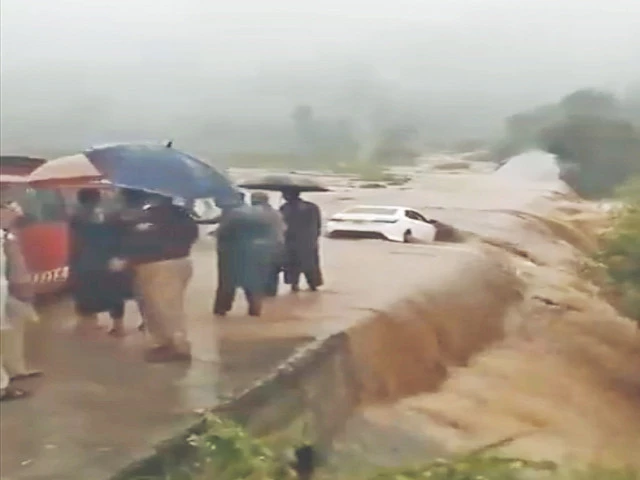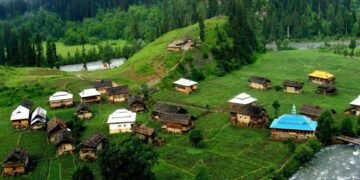MUZAFFARABAD/GILGIT: Relentless torrential rains and flash floods have wreaked havoc across Azad Jammu and Kashmir (AJK), Kaghan Valley, and Gilgit-Baltistan (G-B), leaving at least 10 people dead—including women—and hundreds trapped in isolated areas According to Express News, a cloudburst in a suburban area of Muzaffarabad claimed the lives of five members of the same family.
In Neelum Valley, around 50 tourists stranded in Ratti Gali Nullah were rescued, but nearly 500 remain stuck at the base camp after bridges were swept away and roads blocked.
In G-B’s Ghizer district, floods in Khalti swept away five people. The bodies of a woman and a child have been recovered, while three others remain missing. Six houses were completely destroyed, and flash floods in Chitorkhand and Dain Nullah blocked the Ishkoman River, forcing the evacuation of residents from low-lying areas amid fears of a breach.
The State Disaster Management Authority (SDMA) confirmed more casualties: a woman killed by a falling rock in Dana Daliyaar, UC Machhiara, and another woman dead and one person injured after being washed away in Pulandri Nullah.
In Jhelum Valley, three shops and a watermill were destroyed by flooding in Nar Dajian Nullah, while three people trapped in Chhattar Nullah, Poonch, were rescued.
In Bagh district, some 400 tourists were rescued after being trapped when their vehicle was caught in floodwaters. Landslides have blocked the Muzaffarabad–Khyber Pakhtunkhwa link road at Lohar Gali, as well as the Bani Hafiz–Hattian Bala road in Jhelum Valley. Leepa Valley remains cut off at Dudupura, and the Hajira–Abbaspur road in Poonch is blocked at Berri.
Two pedestrian bridges were washed away in Nullah Lawat, while heavy rain in Nathiagali caused three girls to drown in Gilyat Tajwal; two were rescued, but one died.
PMD Issues Glacier Melt Warning
The Pakistan Meteorological Department (PMD) has warned of accelerated snow and glacier melt in G-B, as regional temperatures remain 7–9°C above normal.
The unusual heat is significantly increasing the rate of snow and ice melt, raising the risk of Glacial Lake Outburst Floods (GLOFs). PMD’s Flood Forecasting Division reports both maximum and minimum temperatures above seasonal averages, leading to heavy snowmelt and higher inflows into reservoirs.
Data shows that during the first 10 days of August, inflow into the Tarbela Reservoir during the current kharif season reached 41.8 million acre-feet (MAF)—5.64 MAF above the normal seasonal inflow of 36.16 MAF.
Officials warned that rapid snowmelt could create and expand glacial lakes, posing a serious flood threat to downstream communities. Authorities and residents in vulnerable valleys have been urged to remain alert and take preventive measures.
Monsoon Havoc Continues
The ongoing monsoon season (June–September) has already caused deadly floods, landslides, and displacement nationwide, hitting poorly drained and densely populated regions the hardest.
In Abbottabad, torrential rains blocked the Karakoram Highway (KKH) at multiple points, leaving travelers stranded for hours. Local authorities reported that major nullahs and ravines, including the River Door, overflowed, threatening nearby communities.
A sudden surge of water from upper catchment areas inundated low-lying zones and deposited debris on the KKH, rendering stretches impassable. Rescue and relief teams, supported by traffic police, were deployed to clear the road and assist stranded commuters.

















